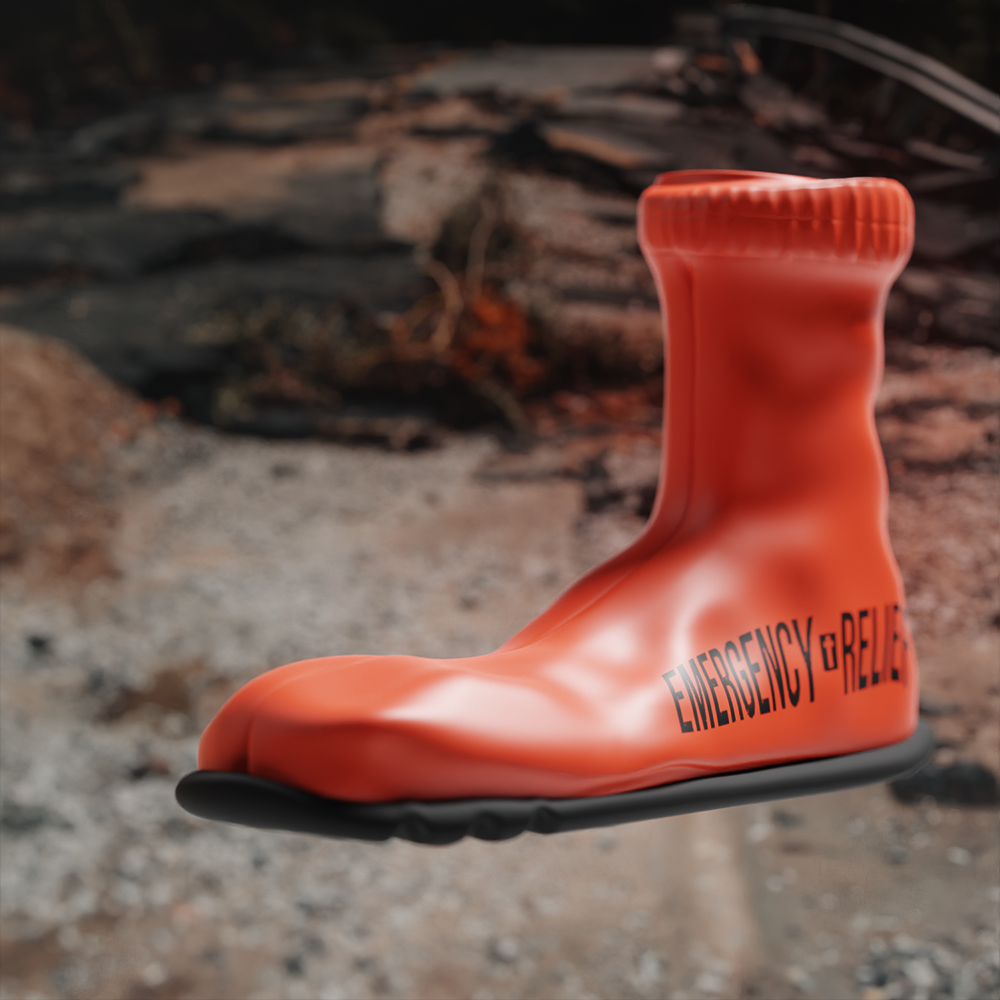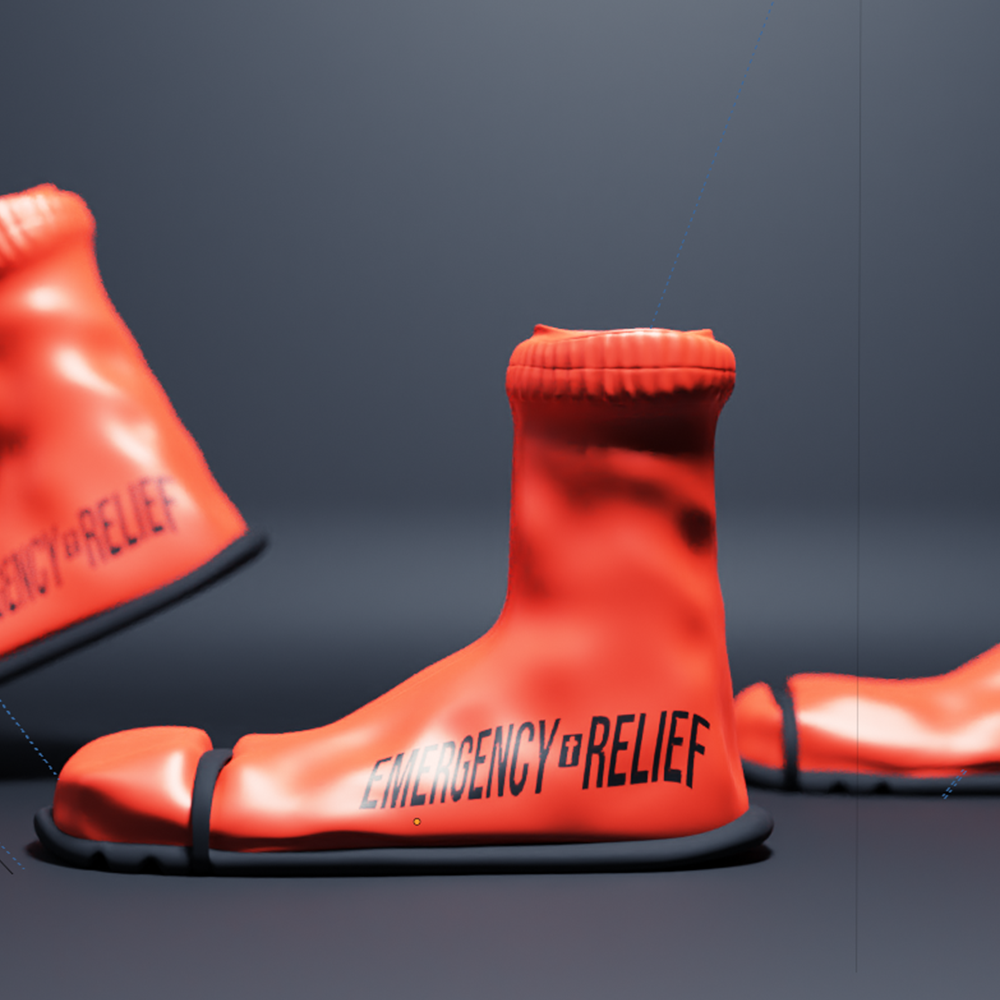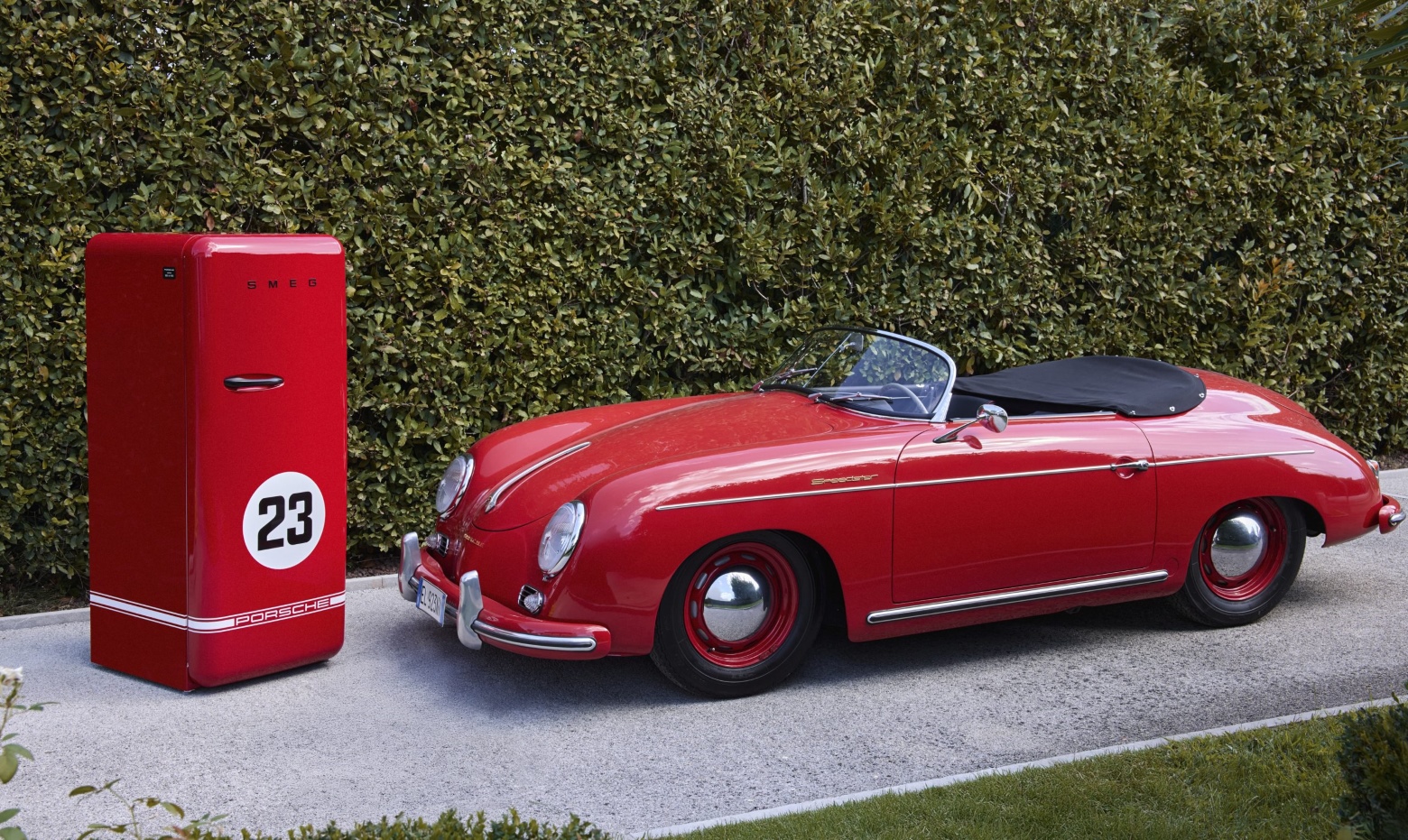In flood-ravaged villages and storm shelters, one of the most common but overlooked casualties is something we rarely consider until it’s gone: shoes. We’ve all seen images of survivors wading through murky water or picking over debris barefoot, exposed to sharp rubble and disease. Beyond the immediate risk of injury, going shoeless in a crisis strips away a small but meaningful layer of dignity, a fact aid organisations have increasingly come to recognise. Walking amid flood wreckage without shoes invites cuts, infections and puncture wounds and it “compromises the survivors’ ability to move and simply lacks dignity,” as the Global Footwear Awards jury noted in 202. In other words, sturdy shoes are more than clothing; they’re lifelines for safety and self-respect.
Designing for disasters isn’t all drones and water filters; that’s where the Emergency Shoe stepped in as an ingenious footwear design that attacks this unglamorous problem head-on. Created by Pratt Institute student Zhe Ji, the Emergency Shoe took top honors in the Social Impact category at the 2022 Global Footwear Awards. The project targets a gap in disaster relief we didn’t know we had, providing an immediate, shareable shoe solution for people who’ve lost everything from the ankle down. In an age of escalating climate disasters, this kind of thoughtful product design feels especially timely. The proportion of people worldwide living in flood-prone areas has shot up by over 20% since 2000, meaning more communities than ever face the risk of fleeing without so much as a sandal on their feet. The Emergency Shoe builds on this insight: it’s a design solution born at the intersection of humanitarian need and creative problem-solving.

One Shoe, Any Foot: Footwear Fit for Emergencies
What exactly makes a shoe an “emergency” shoe? In this case, it’s a clever assembly of features geared toward post-disaster chaos. First, the design is ambidextrous, as a single shoe fits left or right, simplifying distribution when time is of the essence. The shoe isn’t made in multiple sizes; instead, it uses a broad elastic harness that cinches or loosens to accommodate a range of foot shapes. This means relief workers can grab a pile of these shoes and confidently hand them out, knowing they’ll fit most people, from a small child to an adult. No fumbling for the right size, no mismatched pairs, truly one-size-fits-most footwear.
Then there’s the material and colour: Zhe Ji selected a waterproof base so that feet stay dry and protected trudging through floodwaters. The entire shoe is a bright safety orange, the kind of eye-searing hue you’d find on a life vest or rescue buoy, which was a deliberate choice. In a disaster zone, neon orange is as functional as it gets: it makes the shoes (and by extension the person wearing them) highly visible against muddy water or dull wreckage. Visibility can be lifesaving when search crews are scanning for survivors, and it also signals that these odd-looking clogs are issued relief gear. There’s a subtle psychological edge to wearing something purpose-built for crises: it tells everyone that the wearer hasn’t been forgotten.
Finally, the Emergency Shoe pulls a delightfully unexpected double-duty: it can turn into a carry container. The hollow interior and flexible upper can be used to hold small relief supplies, such as bandages, water purifiers, or personal items. Essentially, each shoe can act as a modular package – survivors might keep a few essentials inside one shoe while wearing the other, or carry pairs by their elastic straps with goods tucked in. It’s a pragmatic use of space in situations where bags and boxes are scarce. This way, the shoe isn’t just protecting your feet; it’s helping you transport a bit of what you need. The overall design shows an empathy for life in crisis: every element is pared down to maximise utility under duress.


From Classroom to Crisis Zone: Design with Social Impact
It’s telling that this innovation came not from a big outdoor gear brand or a government lab, but from a graduate design student. Zhe Ji’s work highlights a broader shift in design education toward social impact and real-world problem solving. Design schools today are asking students to grapple with humanitarian issues, climate adaptation, and community resilience, not just aesthetics or market trends. The Emergency Shoe arose from that: its design as an intervention, the kind of project that might spring from a studio assignment on disaster relief or a passionate thesis about human-centred design.
The timing couldn’t be more apt. With climate change amplifying floods, storms and displacement, humanitarian designers are essentially becoming first responders of ingenuity. We’re seeing more initiatives where designers ask, what small thing could make a big difference? In disaster response, that mentality has led to “dignity kits” (packages of personal hygiene items and clothing for displaced women), solar lanterns for communities off the grid, and now, possibly, one-size-fits-all shoes. Even large agencies have started to listen to end-users about these basics. For instance, a recent UNICEF pilot found that adolescent girls in Gaza specifically requested slip-on shoes be added to emergency aid kits, underscoring how overlooked such items can be until someone asks. Relief organisations and designers alike are learning that restoring normalcy and dignity often hinges on humble objects: a bar of soap, a clean garment, a pair of shoes. As one humanitarian effort in the Philippines put it, shoes not only prevent disease but also “provide the owner with dignity and opportunities” to move forward.
The Emergency Shoe is a vivid example of this new wave of design for crisis. It takes something seemingly obvious – people need shoes – and treats it as an urgent design brief. By doing so, it bridges the gap between survival and humanity: protecting feet from harm while also signalling that the wearer’s comfort and self-respect matter in the midst of chaos. And it does all this with a kind of bold, minimalist ingenuity that creative audiences appreciate. There’s a witty simplicity to the concept (“one shoe to rule them all,” one might quip) even as it addresses deadly serious situations.
Crucially, the Emergency Shoe also nudges the footwear industry to rethink its priorities. Footwear is a $365-billion global business obsessed with trends and tech, yet here we have a winning design that’s essentially a reusable rubber boot in safety orange. This contrast isn’t lost on anyone. It suggests that good design isn’t just about carbon fibre soles or viral sneaker drops; it can be about solving unsexy, real problems with elegance and empathy.
In the grand scheme, a slip-on disaster shoe might not grab headlines like a new Nike concept or a couture collaboration. But to someone whose home and shoes were washed away overnight, it could mean everything. By intervening in an unexpected yet essential way, Zhe Ji’s Emergency Shoe shows how thoughtful design can help people regain their footing (literally) when catastrophe strikes. It reminds us that even in an era of AI and space tourism, sometimes innovation is as simple as a dry, intact pair of shoes and that caring about such details is a profoundly creative, humane act.
Posted as part of D5 Digital Design Week 2025: This year’s edition spotlights “Design Where It Matters Most”, a reminder that smart design isn’t just aesthetic, it’s a lifeline. From emergency shelters to solar-powered lights, we’re looking at work that responds to real needs with creativity, care, and impact. The project featured above is a powerful example of how design can step up when it matters most, offering practical solutions without losing sight of human dignity.









